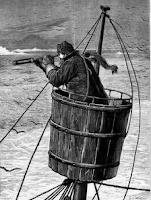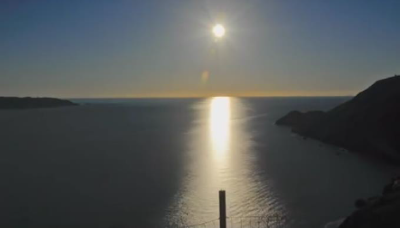83. The Eigerøy Light at a height of 154 feet should not be visible from a ship 28 miles away on a spherical Earth
“The Egerö Light in Norway is 154 feet above high water and visible from 28 miles statute miles where it should be 230 feet below the horizon.”
Probably a bogus observation, but in any case Dubay and Samuel Rowbotham can't do trigonometry.
For evidence that the quoted observation is bogus, click here:
Why Dubay's lighthouse quotes are bogus
However, if you want to take the observation as genuine read on to see why this still does not add up to a proof.
Using the correct calculation, the observer on the ship would have to be at a height of 109 feet.
From the deck of a ship that would mean that the observer would be about 90 feet too low to see the lighthouse.
However, as with so many of Dubays "proofs" this is taken from Samuel Rowbotham's "Zetetic Astronomy: Earth Not a Globe" published in 1881.
The relevant paragraphs from the book are:
 Now the observation can make sense on spherical Earth. In 1881 the ships that would be observing the lighthouse would be sailing ships or steam ships that still had sails as a back-up. Look-outs on those ships would be placed in a crows nest near the top of the main mast.
Now the observation can make sense on spherical Earth. In 1881 the ships that would be observing the lighthouse would be sailing ships or steam ships that still had sails as a back-up. Look-outs on those ships would be placed in a crows nest near the top of the main mast.
 Here is a typical ship of the time with a mast height of 145 feet.
Here is a typical ship of the time with a mast height of 145 feet.
https://en.wikipedia.org/wiki/Balclutha_(1886)
So in summary, Samuel Rowbotham may have quoted an accurate account of how far out to sea the lighthouse could be seen, but he was still as ignorant of trigonometry as Dubay. He performed the incorrect calculation and used this to incorrectly conclude that the Earth could not be a sphere. Although it would have made no difference to his conclusion, he also makes the mistake of assuming that the ships lookout would be standing on the deck when the best vantage point on a sailing ship is from the top of the main mast / crows nest.
< Prev 81-90 Next >
Probably a bogus observation, but in any case Dubay and Samuel Rowbotham can't do trigonometry.
For evidence that the quoted observation is bogus, click here:
Why Dubay's lighthouse quotes are bogus
However, if you want to take the observation as genuine read on to see why this still does not add up to a proof.
Using the correct calculation, the observer on the ship would have to be at a height of 109 feet.
From the deck of a ship that would mean that the observer would be about 90 feet too low to see the lighthouse.
However, as with so many of Dubays "proofs" this is taken from Samuel Rowbotham's "Zetetic Astronomy: Earth Not a Globe" published in 1881.
"Many instances could be given of lights being visible at sea for distances which would be utterly impossible upon a globular surface of 25,000 miles in circumference. The following are examples:-
....
Allowing 16 feet for the altitude of the observer .....
The Egerö Light, on west point of Island, south coast of Norway, is fitted up with the first order of dioptric lights, is visible 28 statute miles, and the altitude above high water is 154 feet. On making the proper calculation it will be found that this light ought to be sunk below the horizon 230 feet."
 Now the observation can make sense on spherical Earth. In 1881 the ships that would be observing the lighthouse would be sailing ships or steam ships that still had sails as a back-up. Look-outs on those ships would be placed in a crows nest near the top of the main mast.
Now the observation can make sense on spherical Earth. In 1881 the ships that would be observing the lighthouse would be sailing ships or steam ships that still had sails as a back-up. Look-outs on those ships would be placed in a crows nest near the top of the main mast."... masts were still to be found on many merchant and passenger ships well into the 1900s"
Source: https://www.uh.edu/engines/epi1338.htmThe 109 feet of elevation required to see the Eigerøy Light on a spherical Earth is absolutely consistent with the elevation we could expect for look outs stationed on the main mast.
 Here is a typical ship of the time with a mast height of 145 feet.
Here is a typical ship of the time with a mast height of 145 feet.https://en.wikipedia.org/wiki/Balclutha_(1886)
< Prev 81-90 Next >





Comments
Post a Comment